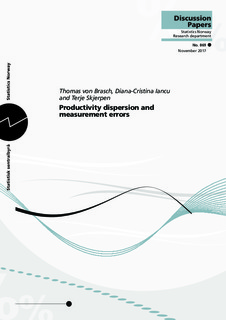| dc.contributor.author | Brasch, Thomas von | |
| dc.contributor.author | Iancu, Diana-Cristina | |
| dc.contributor.author | Skjerpen, Terje | |
| dc.date.accessioned | 2018-01-11T13:48:31Z | |
| dc.date.available | 2018-01-11T13:48:31Z | |
| dc.date.issued | 2017-11-24 | |
| dc.identifier.issn | 1892-753X | |
| dc.identifier.uri | http://hdl.handle.net/11250/2477042 | |
| dc.description.abstract | We outline a novel procedure to identify the role of measurement errors in explaining the empirical dispersion in productivity across establishments.
The starting point of our framework is the typical errors-in-variable model consisting of a measurement equation and a structural equation for the true productivity. The key idea in our identification strategy is to estimate the variance of the measurement errors in order to deduce the variance of the companion true variable. Specifically, we estimate a dynamic panel model where establishment-specific productivity is modelled as a first order autoregressive process augmented with year dummies and establishment-specific unobserved heterogeneity, represented by random effects. Considering 3 Norwegian manufacturing industries, as an example, we find that about 4 per cent of the measured dispersion is caused by measurement errors. | nb_NO |
| dc.language.iso | eng | nb_NO |
| dc.publisher | Statistics Norway, Research department | nb_NO |
| dc.relation.ispartofseries | Discussion Papers;No. 869 | |
| dc.subject | Arbeidsproduktivitet | nb_NO |
| dc.title | Productivity dispersion and measurement errors | nb_NO |
| dc.type | Working paper | nb_NO |
| dc.subject.nsi | VDP::Matematikk og Naturvitenskap: 400::Matematikk: 410::Analyse: 411 | nb_NO |
| dc.source.pagenumber | 14 s. | nb_NO |
